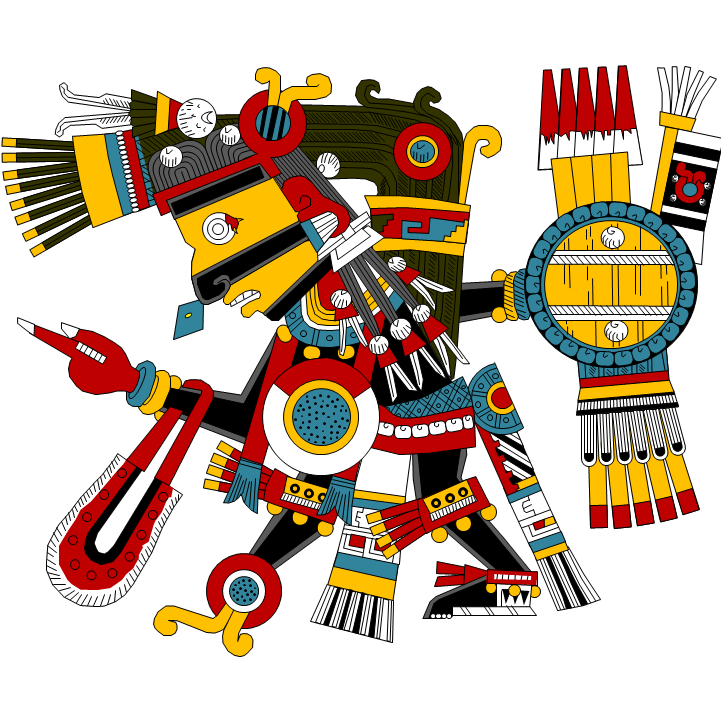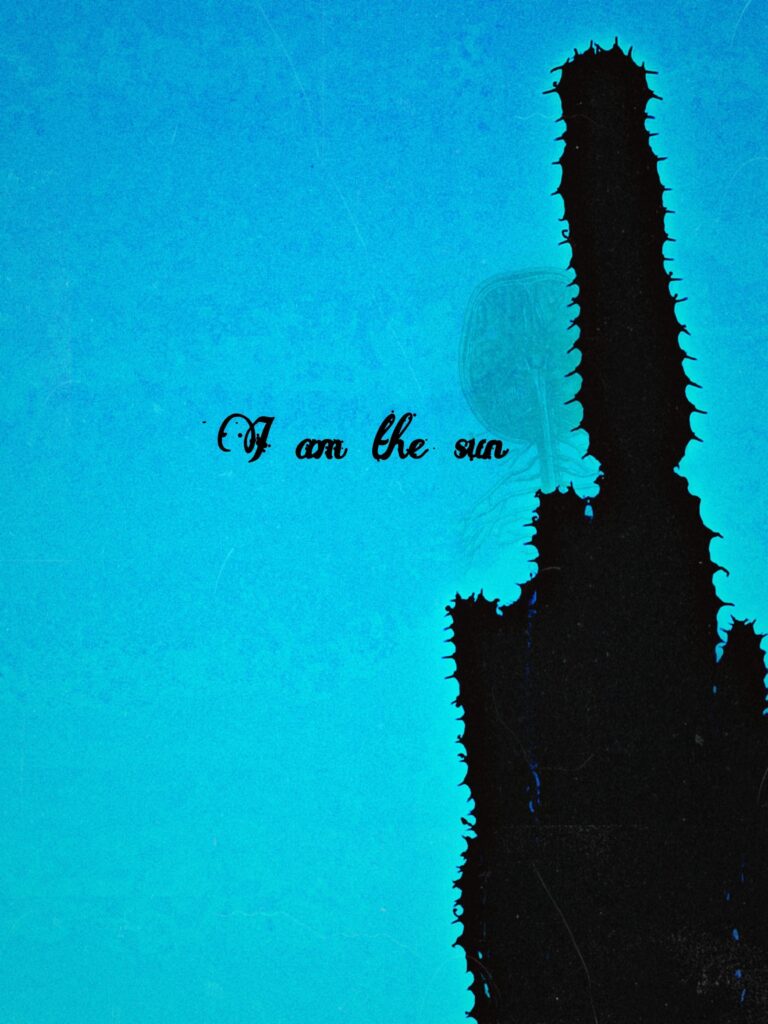
Tezcatlipoca as depicted in the Codex Borgia
All the native lays are interwoven with such obscure metaphors that there is hardly a man who can understand them unless they are studied in a very special way and explained so as to penetrate their meaning. For this reason I have intentionally set myself to listen with much attention to what is sung; and while the words and the terms of the metaphors seem nonsense to me, afterwards, having discussed and conferred, they seem to be admirable sentences, both in the divine things composed today and in the worldly songs.
Diego Durán
I
I despise language. A wise being once said that poets fear the power of language. Words are violence; they dictate like dictations, they surveil like Lacan’s big Other, the Father. The Christian language planes us down into repression.
“When the schoolteacher questions her pupils, she does not inform herself about anything, just as little as she communicates information when she teaches them a grammatical or mathematical rule. She ‘teaches,’ she gives orders, she commands. The professor’s commands are not external; they are not additions to what we learn from him. They do not derive from meanings that precede them, nor are they consequences of information: giving orders is always, from the very beginning, about other orders — that is why giving orders is redundancy.” (2015)
Language consists of this redundancy; of a pure excess. It is praxis all the way down. Its peculiarity lies in its radical rupture with base matter — in its ability to draw lines between distinct forms. But it is also sets of rules surrounding these acts of line-drawing. Without rules, the whole system collapses into meaninglessness. We seem, in modernity, to have lost the insight of language as magic (and perhaps the connection is partly lost due to the Protestant interpretation of magic). Thoth was not only language itself but also magic; married to Maat, order, truth, and divine justice. There are multiple relations revealed in this dynamic and the arrangements of these concepts. Language as such, from the standpoint of ancient Egyptian culture, is bound to rules, which in turn are bound to cosmic order. Let us recall what it is to remember the birth of written language — what it is to create a secret sign-language with our friends in childhood. We are so enclosed in words, in abstractions, in data, that these machines are lost.
Computers are magical machines — literally. They are founded upon binary rules, axioms, that build a syntax and produce patterns of calculation. In this sense, language is in a love affair with order. And it is precisely in this aspect that language is terrifying to a poet. The immanent threat of constantly reducing the sacred, the inner, experience itself, into a structure, is the threat of self-annihilation through the cataloging of the poet’s own subject; to become a thing. Poetry is a linguistic expression that declares war on language’s marriage to order.
Bertrand Russell is in many ways the savior of language. His letter to Gottlob Frege, showing how Frege’s logic was self-contradictory, saved language from collapsing into meaninglessness. Zermelo and Fraenkel pumped further life into this virus by sacrificing simplicity for the virus’s own survival. Plato’s theory of ideas could continue to live on; Thoth and Maat in union. Furthermore, Kurt Gödel is the poet’s savior, as he demonstrated that every ordered (that is, consistent) language is necessarily incomplete.
The Aztecs’ understanding of language can be contrasted with the ancient Egyptian tradition. Quetzalcōātl, the feathered serpent, was to the Aztecs what Thoth and Maat were together. But Quetzalcōātl was not the god of magic; this role was instead given to his brother and nemesis Tezcatlipoca. Together, in their war against one another, the world came into being. Tezcatlipoca, the “smoky mirror,” magic itself, the invisible, the night, is the aspect of reality that the poet desires; who uses language as magic to annihilate any sort of goal — to annihilate logos (Quetzalcōātl) itself. Tezcatlipoca is the elusive ground upon which Being as such stands; the observer and the observed, mirroring the entire kaleidoscopic reality back onto itself.
“Oh, great lord, ruler of the Near and the Nigh! Immanence enclosing itself; letting the forms reflect within you and freeing us from the dictatorship of things… Let me never be seen, just as you are never seen. Let me be destroyed in your mercy.”
The Aztecs’ understanding of this intimate dynamic between language as order and language as magic points precisely toward the forbidden knowledge that I here seek to vomit forth. Gödel reveals the necessary incompleteness of language’s territorializations; thereby he also exposes this duality within the nature of language. On the one hand, language breaks down if it lacks its redundancy and its rules. On the other, it renders itself limited and incomplete in its establishment of meaning. Language is a battlefield between these gods. The poet fears language precisely because of this violence — of being reduced, constrained, made incomplete — for what the poet desires is language’s liberation from itself. The contradictions in Frege’s system are exactly what do it justice; they mirror language’s ability to produce nonsense. This nonsense is not that of Deleuze’s “surface level,” represented by the innocent wordplay of children in The Logic of Sense; it is Antonin Artaud’s violent internal level of nonsense, mirrored in the dialectic between Tezcatlipoca and his brother Quetzalcōātl. This internal level of total non-sense is the invisible domain over which Tezcatlipoca reigns.
“Artaud says that Being, which is nonsense, has teeth. In the surface organization which we called secondary, physical bodies and sonorous words are separated and articulated at once by an incorporeal frontier. This frontier is sense, representing, on one side, the pure ‘expressed’ of words, and on the other, the logical attribute of bodies. Although sense results from the actions and passions of the body, it is a result which differs in nature, since it is neither action nor passion. It is a result which shelters sonorous language from any confusion with the physical body.” (1990)
The poet’s pursuit of Georges Bataille’s inner experience makes use of language with awareness of this nonsense. Russell’s paradox is an ontological threat; one can sense how the god of Night smiles at the end of the tunnel of paradox. It is in this quality that language is magic — not merely as praxis, as power, as a way of coding, but in how language itself is written upon a body without organs. The organization of language must be created, repeated, and propagated like a virus through the schoolteacher, through mother and father, through police and the justice system, through academia and journalism, through politicians and fascists. For its existence is constantly threatened by its own inherent nature — its freedom to draw lines across an immanent plane.
Is it not in this capacity that the human being is a “white slate”? Or rather — is it not in this capacity that Being itself is a white slate? The cornerstone of empiricism arises from this ability for radical freedom — the subject’s ability to draw lines, to sketch like a madman, to diagram schizoidly across its whole body. Chakras as a map of the body to hold it together. Language territorializes in this way; we make sounds and roar. Humans have sound to mark their territory just as cats have scent. Language is functional only in this aspect — not as a tool but as magic. Language as such is thus the logos from which reality flows. God spoke; he uttered existence. In this sense, Being — or rather, Becoming — is a direct result of language: the linguist studies not only the structural forms of language but also the structural forms of the cosmos. Things only surface through a construction of meaning — an arrangement of associations of earlier forms. The cells in our bodies communicate with each other; they speak, they have a language. Our bodies — a division of unicellular organisms into here and now. Actualization comes from this communication, from the set of local rules, from repetition and differentiation. My body is a result of these processes — of an infinite chain of cell divisions, of atoms’ struggle to break the silence and speak themselves into existence, thus tearing holes into the beast of nothingness.
I can almost see it — how the cells have communicated themselves into this body. Through an intimate dialogue of molecules with atoms. Their rules have indeed both created the conditions and the limitations of this body’s potentiality. And it roars. My whole nervous system trembles in all the damned clamoring. It drives me insane, so I too roar; I go mad. They — the whole damn lot — I am never alone; even Satan is the lord of the flies — they scream to me in desire, as do the bodies outside this damned machinery.
Language is violent. Inside and out. And I am afraid of my life— in every sense of the word: afraid of life.
“I could have told myself: value, authority—this is ecstasy; inner experience is ecstasy; ecstasy is, it seems, communication, which is opposed to the ‘turning in on oneself’ of which I have spoken. I would have in this way known and found (there was a time when I thought myself to know, to have found). But we reach ecstasy by a contestation of knowledge. Were I to stop at ecstasy and grasp it, in the end I would define it. But nothing resists the contestation of knowledge and I have seen at the end that the idea of communication itself leaves naked—not knowing anything. Whatever it may be—failing a positive revelation within me, present at the extreme—I can provide it with neither a justification nor an end. I remain in intolerable non-knowledge, which has no other way out than ecstasy itself.” (1988)
I am not a poet by virtue of vomiting stupid arrangements of letters and words. I am a poet by virtue of using language to reach ecstasy. I want to break it apart and see the mirror that lies beyond words. The mirror that can only be described as ecstasy — the self-revealing mirror in which totality is enclosed. I want to write poetry that feels like the moment before death. These are my offerings to the gods, to the sun: language itself.
- Deleuze, Gilles & Guattari, Félix. 2015. Tusen platåer. TankeKraft.
- Deleuze, Gilles. 1990. Logic of Sense. The Athlone Press.
- Bataille, George. 1988. Inner Experience. State University of New York.
- https://www.famsi.org/research/curl/nezahualcoyotl_intro.html (2025-10-22)
